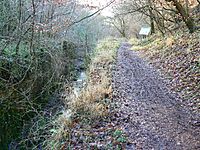Siccaridge Wood facts for kids
Siccaridge Wood is a special nature reserve in Gloucestershire, England. It covers about 26.6 hectares (that's like 68 football fields!). This amazing place is listed as a Key Wildlife Site, which means it's super important for animals and plants.
The Gloucestershire Wildlife Trust has been looking after Siccaridge Wood since 1986. They work with the Bathurst Estate, who own the land. Before that, the Forestry Commission managed the wood.
Contents
Discover Siccaridge Wood
This beautiful wood is located in the Frome Valley, close to a village called Sapperton. It sits on a ridge made of limestone, with the River Frome on one side. It's also right next to the Sapperton Valley nature reserve and the Daneway Banks nature reserve.
The wood has slopes facing both north and south. The soil is deeper and richer at the bottom of the slopes. But at the top, the soil is thin and rocky.
A Woodland with History
Siccaridge Wood is an ancient woodland. This means it has been a forest for hundreds of years! People have managed it for a long time using a method called coppicing. This is where trees are cut down to ground level, and then new shoots grow back. This helps the wood stay healthy and provides timber.
In the past, this wood was very busy. People used the mature trees for things like building ships. The coppiced wood was used for making hurdles (fences) and other items. During World War II, some big trees were removed. In the 1950s, new trees like conifer and beech were planted.
Records show that Siccaridge Wood has been around since at least 1576! Back then, it was called Sickeridge Coppice. The name Siccaridge comes from old English words meaning 'secure, safe ridge'. The Bathurst Estate bought the wood in 1861. There were even three small cottages at the edge of the wood, probably where woodcutters lived.
Visiting the Reserve
The wood is right next to the old Thames and Severn Canal. You can get into the reserve from the canal path or from the road to Daneway and Tunley. There are many paths to explore inside the wood. One main path is called Morley Ride, named after a past chairman of the Gloucestershire Wildlife Trust.
Siccaridge Wood has old trees, areas that have been coppiced, and open grassy spots called glades. It's home to many different plants, birds, insects, and small mammals.
Amazing Trees and Plants
You'll find many types of trees growing here. Some common ones include ash, silver birch, and beech. There are also old pedunculate oak trees.
Beneath the taller trees, there's a layer of shrubs. These include hazel, spindle, wild privet, guelder-rose, and the wayfaring-tree. Some of the hazel plants are very old and large.
Special Flowers
Siccaridge Wood is famous for its beautiful lily-of-the-valley flowers, which grow on the slopes. You might also spot some rarer plants like angular Solomon's-seal, herb paris, and bird's-nest orchid.
In spring, large areas of the wood are covered in bluebells, wood anemones, dog violets, and primroses. Other lovely flowers include yellow archangel, ramsons, sanicle, and early purple orchid.
Animals of Siccaridge Wood
This nature reserve is a great place for wildlife. Many different animals call it home.
Birds and Mammals
Birdwatchers can spot birds like the whitethroat, nightingale, turtle dove, coal tit, goldcrest, and song thrush.
One very special animal here is the common dormouse. These tiny, cute creatures are protected by law. Other small mammals include the wood mouse and the yellow-necked mouse. You might also see fallow deer and roe deer visiting the wood.
Insects and Snails
The open paths and glades in the wood attract many butterflies. You might see the pearl-bordered fritillary, silver-washed fritillary, and comma butterflies.
Even snails are interesting here! Some types of molluscs found include the large Roman snail and the tiny great pellucid glass snail.
The wood also has many wood ant nests. Some of these ant hills can be as tall as half a metre!
Looking After the Wood (Conservation)
The main goal for Siccaridge Wood is to make it even better for wildlife. This means carefully thinning some areas to create a "high forest" with tall, strong trees. They also remove planted conifer trees. The hazel coppice is managed in a way that helps the dormouse population thrive.
Walks and Nearby Reserves
There's a special guide that tells you about walks in the Golden Valley. It includes information about Siccaridge Wood and four other nearby nature reserves: Strawberry Banks SSSI, Three Groves Wood, Daneway Banks SSSI, and Sapperton Valley. The walks also take you through other ancient woodlands and along parts of the old Thames and Severn Canal.


